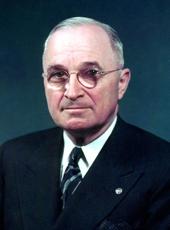
Statement by the President on the Change in the Public Debt During His Term of Office
THERE HAVE recently been a number of misleading or inaccurate statements made concerning the budget figures and the change in the public debt during my term in office. There is no excuse for such statements, because the relevant information has all been made public many times. A glance at the table printed in the Budget in Brief would be enough to check the facts.
The story may be most conveniently summarized in three time periods.
1. From April 12, 1945, to June 30, 1946, we were completing the financing of World War II.
When I became President, World War II was in full tide. Twelve million men and women were in the Armed Forces and were distributed to the far corners of the earth. Another 10 million men and women were engaged in munitions production. They were employed in defense plants working day and night to produce the armaments that finally permitted us to prevail over the Nazis and the Japanese imperialists. Many billions of dollars in war contracts were outstanding to enable American industry to schedule the production required to win the war.
All of this required budget expenditures of billions of dollars; and the Treasury, in order to provide this money, was just getting ready in April 1945 to undertake the seventh war loan. When hostilities ceased, I cut the war spending program by over $60 billion. However, this reduction could not be accomplished immediately. A large volume of war expenditures was still in process, and as the year 1945 proceeded, another and final war loan, the Victory Loan, was completed to provide the funds needed for concluding war operations and financing the demobilization.
During the fiscal year from July 1, 1945, to June 30, 1946, the budget for which had been submitted early in 1945, there was a budget deficit of $20.7 billion, reflecting the carryover of wartime spending. The public debt rose from $234.1 billion on April 12, 1945, to a peak of $279.2 billion in February 1946, and thereafter declined to $269.4 billion on June 30, 1946.
2. July 1, 1946, was the beginning of the first fiscal year following the end of the war. By that date the wartime Armed Forces had been largely demobilized; most of the war contracts had been liquidated. We had nearly completed our reconversion. From then until June 30, 1950, we were in a period of generally high employment and national income. For those 4 fiscal years we had a net budget surplus of $4.3 billion. By applying this surplus and some of the wartime cash reserves, the public debt was reduced substantially, reaching a low point of $251.2 billion in June 1949, and amounting to $257.4 billion on June 30, 1950.
This was a good record, though it should have been better. I recommended frequently during this period that our surpluses be larger and our debt reduction greater. But the untimely and unfair tax reduction of 1948, passed by the 80th Congress over my veto, prevented this.
SUMMARY OF BUDGET AND PUBLIC DEBT FIGURES
|
[ In billions of dollars ] |
Budget Surplus (+)
Budget expendi- or Public
Date or fiscal year ending receipts tures deficit (--) debt
Date:
April 12, 1945 234.1
February 28, 1946 (peak) 279.2
June 27, 1949 (Post World War II low point) 251.2
Fiscal year ending:
June 30, 1946 40.0 60.7 --20.7 269.4
June 30, 1947 40.0 39.3 +.7 258.3
June 30, 1948 42.2 33.8 +8.4 252.3
.June 30, 1949 38. 2 40.0 --1.8 252.8
June 30, 1950 37.0 40.1 --3.1 257.4
June 30 1951 48.1 44.6 +3.5 255.2
June 30, 1952 62.1 66.1 --4.0 259.1
June 30, 1953 (estimate) 168.7 74.6 --5.9 263.9
June 30, 1954 (estimate) 168.7 78.6 --9.9 273.8
1Estimated on basis of present tax laws.
3. Beginning with the fiscal year 1951, we entered the period which followed the Communist aggression in Korea. Our defense expenditures were sharply increased, and the Congress increased taxes markedly, though not as much as I recommended. During the first 2 fiscal years following the invasion of Korea, we came very close to following the pay-as-we-go policy I recommended. For the 2 fiscal years 1951 and 1952 we had a net budget deficit of about $½ billion, and the public debt rose less than $2 billion.
Since last June, however, as defense expenditures have continued to rise, we have begun to depart seriously from the pay-as-we-go policy. It is now estimated that the present fiscal year will show a budget deficit of $5.9 billion, and if no changes are made in present tax laws, the fiscal year 1954 will show a budget deficit of $9.9 billion. In keeping with the general policy I have established, I am not making specific tax recommendations to the new Congress. I wish to make it plain, however, that I do not consider it prudent or wise for this country to depart, at a time of high and rising employment and national income, from a pay-as-we-go policy for defense expenditures.
Harry S Truman, Statement by the President on the Change in the Public Debt During His Term of Office Online by Gerhard Peters and John T. Woolley, The American Presidency Project https://www.presidency.ucsb.edu/node/231324
